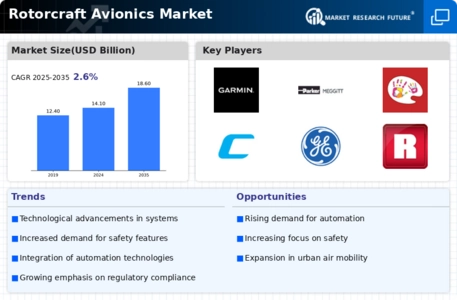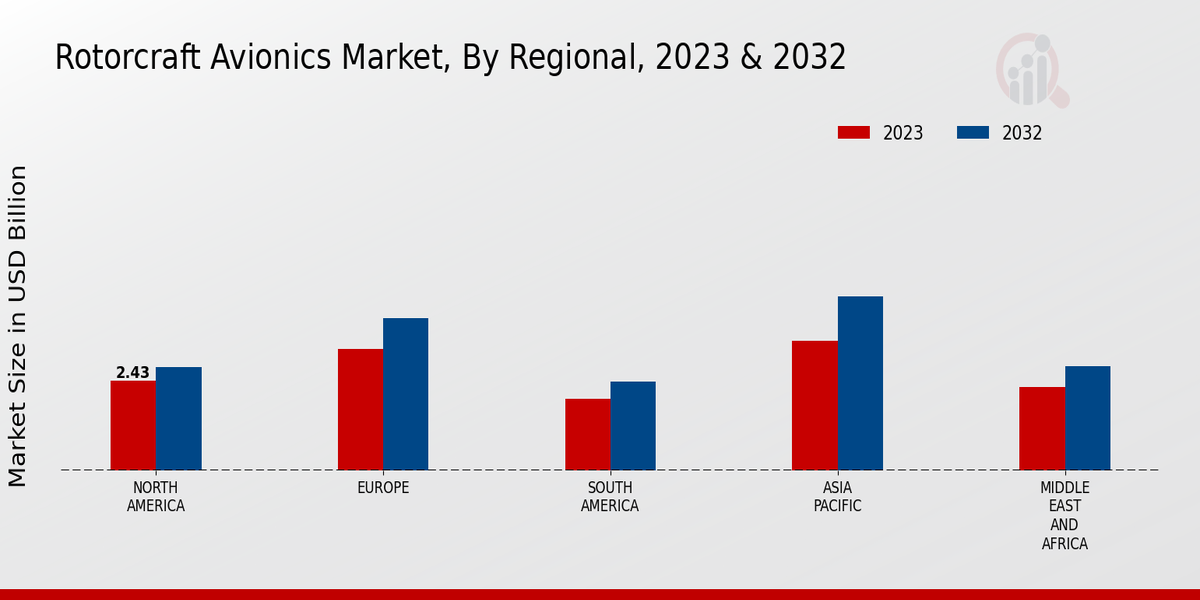Growth in Civil Aviation
The expansion of the civil aviation sector is a key driver for the Global Rotorcraft Avionics Market Industry. As urban air mobility and air taxi services gain traction, there is a growing need for advanced avionics systems that ensure safe and efficient operations. The rise in helicopter tourism and emergency medical services further fuels this demand. With the market projected to grow to 14.1 USD Billion in 2024, the civil aviation sector's increasing reliance on rotorcraft for various applications highlights the necessity for sophisticated avionics solutions that enhance operational efficiency and safety.
Market Growth Projections
The Global Rotorcraft Avionics Market Industry is poised for notable growth, with projections indicating a market size of 14.1 USD Billion in 2024 and an anticipated increase to 18.6 USD Billion by 2035. This growth reflects a compound annual growth rate of 2.56% from 2025 to 2035, driven by various factors including technological advancements, increasing safety demands, and military modernization efforts. The market's expansion is indicative of the broader trends in aviation, where the integration of sophisticated avionics systems is becoming essential for operational efficiency and safety.
Technological Advancements
The Global Rotorcraft Avionics Market Industry is experiencing rapid technological advancements, particularly in the areas of flight control systems and navigation technologies. Innovations such as synthetic vision systems and advanced autopilot functionalities enhance safety and operational efficiency. For instance, the integration of digital flight data recorders and enhanced situational awareness systems is becoming commonplace. These advancements not only improve pilot decision-making but also reduce the likelihood of accidents. As a result, the market is projected to reach 14.1 USD Billion in 2024, reflecting the growing demand for sophisticated avionics solutions.
Military Modernization Programs
Military modernization programs across various nations are significantly influencing the Global Rotorcraft Avionics Market Industry. Governments are investing heavily in upgrading their rotorcraft fleets to enhance operational capabilities and maintain strategic advantages. This includes the integration of advanced avionics systems that improve communication, navigation, and surveillance. For example, the United States has initiated several programs aimed at modernizing its military rotorcraft, which is expected to drive demand for advanced avionics solutions. The anticipated growth in military spending is likely to bolster the market, contributing to a compound annual growth rate of 2.56% from 2025 to 2035.
Regulatory Compliance and Standards
The Global Rotorcraft Avionics Market Industry is significantly shaped by regulatory compliance and evolving standards. Governments and aviation authorities are continuously updating regulations to enhance safety and operational efficiency. Compliance with these regulations often necessitates the adoption of advanced avionics technologies, such as flight data monitoring systems and automated maintenance tracking. As operators strive to meet these stringent requirements, the demand for innovative avionics solutions is likely to increase. This trend is expected to contribute to the market's growth trajectory, with projections indicating a rise to 18.6 USD Billion by 2035.
Increasing Demand for Safety Features
Safety remains a paramount concern in the Global Rotorcraft Avionics Market Industry, driving the demand for advanced safety features. Regulatory bodies are increasingly mandating the incorporation of safety systems such as Terrain Awareness and Warning Systems (TAWS) and Traffic Collision Avoidance Systems (TCAS). These systems are designed to mitigate risks associated with rotorcraft operations, particularly in urban environments. The emphasis on safety is likely to contribute to market growth, with projections indicating a rise to 18.6 USD Billion by 2035. This trend underscores the industry's commitment to enhancing safety standards and reducing accident rates.

























